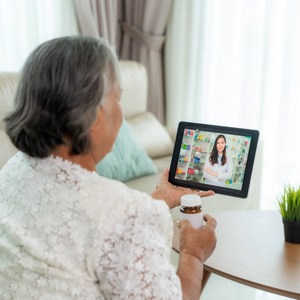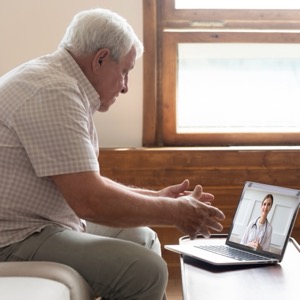By Gina Shaw
Patient outcomes for telehealth visits to pharmacist-run specialty medication management clinics in a rural health system did not significantly differ from in-person visits, indicates research presented at ASHP Pharmacy Futures 2024, in Portland, Ore. (poster 10-M).

“As we are shifting to adopt more telehealth visits, it is very helpful to know that both telehealth and in-person medication management are effective, especially in facilities like ours in Northern Kentucky—rural areas where patients have to travel over an hour just to get healthcare,” said presenting author Chantell Cantrell, PharmD, a PGY-2 pharmacy resident at St. Elizabeth Healthcare, a multi-facility healthcare system located in Northern Kentucky and Southeastern Indiana.
A limited number of studies have directly compared in-person and telehealth visits within pharmacist-run medication management clinics, particularly in the context of specialty areas such as infectious disease, gastroenterology and dermatology, Dr. Cantrell noted. This retrospective study enrolled 94 patients between Jan. 21, 2022, and Dec. 31, 2023; of those, 78 were included in the primary outcome. (This was because not all of the 23 participants with hepatitis C obtained 12-week sustained virologic response [SVR] lab work. The data reported in the hepatitis C primary outcome reflect the seven patients who obtained the lab work and achieved SVR.)
Because patients who had “mixed” visits (both in-person and telehealth) were excluded, the number of participants was relatively small, Dr. Cantrell acknowledged.
The study compared telehealth with in-person visits on several primary outcomes:
• Hepatitis C: achieved SVR after treatment was completed
• HIV: achieved undetected viral load from initiation to follow-up
• Inflammatory bowel disease: change in Crohn’s Disease Activity Index and patient-reported outcomes scores from initiation to follow-up
• Dermatology: change in body surface area from initiation to follow-up
Secondary outcomes included time from referral to initial visit, time from initial appointment to start of medication, number of no-show rates and the percentage of patients receiving recommended vaccines.
All primary and secondary end points of the study were statistically insignificant, indicating there was no difference in outcomes between in-person and telehealth medication management visits. These results suggest that for patients with chronic conditions, both telehealth and in-person appointments with pharmacists are viable and effective options for ongoing disease management.
For example, of the seven hepatitis C patients who obtained 12-week SVR lab work, two of the three in-person patients achieved SVR, and all four of the telehealth patients achieved SVR. Among HIV patients, 50% achieved undetectable viral load in both groups.
“It is often very easy and convenient for patients, especially those in rural areas and those who are elderly and less able to get out as much, to do telehealth visits, so it is reassuring to know that they are getting the same level of care with no difference in outcomes,” Dr. Cantrell said. “Whether via telehealth or in person, pharmacist-led medication management clinics can positively impact the care of patients living with complex disease states requiring specialty medications by evaluating and identifying appropriate treatment options, monitoring pertinent lab work, supporting patients with adherence, aiding in access to medication, and identifying and administering recommended immunizations.”
Dr. Cantrell reported no relevant financial disclosures.




